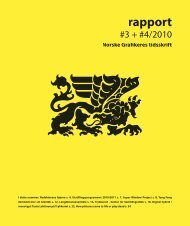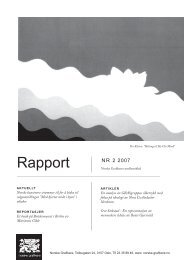Create successful ePaper yourself
Turn your PDF publications into a flip-book with our unique Google optimized e-Paper software.
Año 2005Mauro GiaconiESTACIONAMIENTO18 de agosto al 10 de setiembreMariela YeregiHIPERTEXTO15 de setiembre al 10 de octubreUschi GröppelVALOR DE USO13 de octubre al 5 de noviembreLorraine GreenN S E O10 10 al 30 de noviembreMartin BonadeoCHOCLO INTERACTIVO2 al 20 DiciembreAño 2006Elisa StradaCLASES DE APOYO16 de marzo al 18 de abrilAdrián Villar RojasESTAS SON LAS POSSIBILIDADESDE QUE TE PASA ALGO20 de abril al 5 de junioTomás Espina y Matías GiuliniDOWNTOWN´S MARTINIQUE7 de junio al 17 de julioCristian SeguraMRADOR URBANO17 de agosto al 15 de septiembreCecilia MandrileLA POSTA19 septiembre al 14 de octubreAndres ParedesPULMONCITONoviembre - DiciembreAño 2007Ricardo PimentaBRINDISJunio - AgostoAd or Art? Contemporary Art in the StreetLucretia UrbanoIn 2005, during the renovations of theexhibition spaces at the prestigiousRicardo Rojas Cultural Centre at theUniversity of Buenos Aires, the centreasked for new proposals to continueits curatorial programming.The newexhibition-room was under constructionand “wouldn´t open” yet. I proposedGalería del Poste del Rojas (RojasLamp-Post Gallery), which consisted ofa working lamp-post in central BuenosAires reconceived as a gallery space.The lamp-post, in front of the building,took the place of the Contemporary ArtGallery of the Cultural Centre. Throughthis treatment, like a game, The Galeríadel Poste was conceived as a meetingpoint between institutional and publicspace.The Post had a curated programof exhibitions, its own branding througha logo and lamp-post green colour,invitations, press, openings, a catalogueand a budget for the works producedfor this special context.I wanted the project to engagewith the street and compete withreal advertisements. It proposedexploring a concept and method whichdistinguishes itself from the rest of themediated information and urban spacebut also affects, is affected by, andblends with existing advertising andspace.I regarded the gallery as an artistcentered project, which required myparticipation in many aspects. Amongother tasks, I would have to persuadethe engineers of the municipal lightingcompany, in order to get the requiredpermissions. Nevertheless, to mysurprise, everyone was enthused andhappy to join in the project. We evengot the crane for the more complicatedworks. In this way, many peoplewho had never been in contact withcontemporary art got involved, suchas engineers, bureaucrats, secretaries,neighbours and city wanderers, andeven tourists who anxiously awaitedthe openings. The work had to bepresented to the public space, to thepassers-by walking along Corrientesstreet, it had to resist the climate, andeven risk vandalism. We could, duringcertain times of day, lose all control ofthe situation.The Gallery that never closesThe lamp-post stands on the everbusyCorrientes avenue. The avenueis famous because it ‘never sleeps’,so it seemed natural that the Galeríadel Poste would ‘never close’. Thegallery existed amongst the 24/7bustle, its voice but one amongstthe attention demanding signs ofcity life. Traditionally, printmakingmultiplied images that facilitateddissemination and could commandgreater attention, much like grandbillboard advertisements, or even likethe more modest flyers that anyone cantape to a wall, or, perhaps, lamp-post.However, the cityscape doesn’t justdemand attention through images norprints. Many different forms and modesof address are continuously employed –through the experience and structuresof spaces, through public and privatesservices, through strange accidentsthat happen, through graffiti, becauseof our collective ideas of cities and ourprivate experiences of them. Becauseof this very diverse, active and wellknown Argentine artists were invited topresent proposals for this new gallery –some with links to printmaking, and itstraditions and history, others not – butall developing the lamp-post into anexperimental laboratory that woulddeal with the complex experience ofthe city and its images. (As an artistmyself, I couldn’t resist to make my ownintervention, and changed the yellowlight bulb for a blue one, a full moonone, and in this way distinguished mypost from the others).For the opening exhibition inSeptember 2005, Mauro Giaconi with hissubtle work, Estacionamiento (Parking),challenged the idea of the Post. Hisimpossibly contorted bicycle baffledcyclists, creating a parking problem atthe door of the Cultural Centre. Somewere brave enough to climb on it, whileothers are still wondering whether it ispossible to straighten it up.Mariela Yeregui usually works in digitalart, with sensors, videos and interfaces,but for for the Post surprised us withknitting. In Hipertexto, she knitted a‘hypertext’ reusing packages of frenchfries,biscuits and milk bags. The processof knitting with plastic packaging was apopular practice in the 70s in Argentina.By making a new dress for the Post, shetouched more than one dear memory.In Valor de uso (Use Value), UschiGröppel covered the Post with fake 10euro notes. They had glue on one side,like Post-its, and were arranged in anascendant spiral. Written upon many ofthe notes was a chain letter evoking SanCayetano. San Cayetano (Saint Cajetan)is the Argentine patron saint of theunemployed, and it is common to askfor his intercession to find work, or tobe thankful for work found. During theproject she gave out euros to continuewith the chain, and people wrote andadded their own wishes. The Post wasthus converted in urban altar, much tothe artist’s amazement.Lorraine Green lived and grew up inBariloche, studied in Buenos Aires, thenmoved back to her distant southerntown. That’s why her points of referencewere always others: the cardinaldirections. When she placed them onthe Post, it revealed that people don’tknow where north was. Bus Nº 60 alsomade its own intervention and bent thesign just on the tip of the N.A different public was invited to thenext opening in charge of MartínBonadeo: he invited pigeons. In hiswork named El choclo interactivo, (Theinteractive cob), the pigeons peckedpatterns into the yellow corn, whichreached over two and a half meters highup the poll of the lamp-post. In March,when school classes begin, Elisa Stradacreated Clases de apoyo (RemedialClasses). She covered over 5 meters ofthe Post with a varied and absurd arrayof offers for teaching and services. ThePost looked like a magnet where signsand announcements of all the city wereposted.In April, on the highest part of the Postand among the foliage of nearby trees,Adrian Villar Rojas´ superhero could befound, half hiding in the middle of theavenue. Estas son las probilidades deque te pase algo (nerd), [These are theprobabilities that something happensto you (nerd)], is a life-sized sculptureyellow guardian that surveyed the16 17





